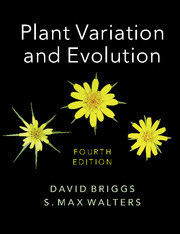Book contents
- Frontmatter
- Contents
- Preface to the Fourth Edition
- Acknowledgements
- Note on names of plants
- List of abbreviations
- 1 Investigating plant variation and evolution
- 2 From Ray to Darwin
- 3 Early work on biometry
- 4 Early work on the basis of individual variation
- 5 Post-Darwinian ideas about evolution
- 6 DNA: towards an understanding of heredity and molecular evolution
- 7 Breeding systems
- 8 Intraspecific variation and the ecotype concept
- 9 Pattern and process in plant populations
- 10 Pattern and process: factors interacting with natural selection
- 11 Populations: origins and extinctions
- 12 Species and speciation: concepts and models
- 13 Allopatric speciation and hybridisation
- 14 Abrupt speciation
- 15 The species concept
- 16 Flowering plant evolution: advances, challenges and prospects
- 17 Historical biogeography
- 18 The evolutionary impact of human activities
- 19 The taxonomic challenge ahead
- 20 Conservation: from protection to restoration and beyond
- Glossary
- References
- Index
4 - Early work on the basis of individual variation
Published online by Cambridge University Press: 05 June 2016
- Frontmatter
- Contents
- Preface to the Fourth Edition
- Acknowledgements
- Note on names of plants
- List of abbreviations
- 1 Investigating plant variation and evolution
- 2 From Ray to Darwin
- 3 Early work on biometry
- 4 Early work on the basis of individual variation
- 5 Post-Darwinian ideas about evolution
- 6 DNA: towards an understanding of heredity and molecular evolution
- 7 Breeding systems
- 8 Intraspecific variation and the ecotype concept
- 9 Pattern and process in plant populations
- 10 Pattern and process: factors interacting with natural selection
- 11 Populations: origins and extinctions
- 12 Species and speciation: concepts and models
- 13 Allopatric speciation and hybridisation
- 14 Abrupt speciation
- 15 The species concept
- 16 Flowering plant evolution: advances, challenges and prospects
- 17 Historical biogeography
- 18 The evolutionary impact of human activities
- 19 The taxonomic challenge ahead
- 20 Conservation: from protection to restoration and beyond
- Glossary
- References
- Index
Summary
In the last chapter we saw how the early biometricians found great difficulty in analysing some of their data because they were unable to decide which part of the variation had a genetic basis and which part was environmentally induced. For animal studies it was Galton (1876) who appreciated the unique value of twins in investigations of the relative roles of nature and nurture in the development of the individual. To study genetic and environmental effects in plants, specimens selected for comparison may be cultivated under a standard set of environmental conditions. Experiments, both historical and recent, have been performed on the assumption that residual differences between plants of the same species, collected from the same or different habitats and grown under such standard conditions, might be considered to have a genetic basis. What follows is a brief survey of early studies. In Chapter 8 we will discuss in some detail the design and interpretation of garden experiments.
It is very interesting to see how cultivation techniques have developed as methods of analysing variation in plants. Experimental cultivation of plants undoubtedly arose as an adjunct to gardening and horticulture, and in Chapter 2 we saw how Ray, collecting the striking prostrate variant of Geranium sanguineum from Walney Island, demonstrated its constancy by cultivating plants in different gardens. The most valuable of these experimental tests were undoubtedly those of a comparative nature. For instance, Mendel cultivated two variants of the Lesser Celandine Ficara verna (Ranunculus ficaria), which he called Ficaria calthaefolia and F. ranunculoides, and reported to Dr von Niessl that each remained distinct (Bateson, 1909).
In a paper of quite remarkable scope, Langlet (1971) has reviewed the extent to which foresters in the eighteenth and nineteenth centuries were using experimental cultivation to study adaptive variation in some of the widespread forest trees of Europe. He cites, for example, the neglected (and largely unpublished) work of Duhamel du Monceau, Inspector-General of the French Navy, who, around the time when Linnaeus published his Species plantarum (1753), brought together an impressive collection of samples of Scots Pine, Pinus sylvestris, from Russia, the Baltic countries, Scotland and Central Europe, and established the first experimental provenance tests for any wild plant.
- Type
- Chapter
- Information
- Plant Variation and Evolution , pp. 37 - 66Publisher: Cambridge University PressPrint publication year: 2016



